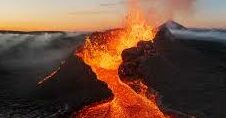By 2026, the Krafla Magma Testbed (KMT) project plans to drill into a volcano to access its magma chamber. The goal is to harness the superheated gases from the magma to generate geothermal energy on an unprecedented scale. This ambitious plan aims to provide renewable and unlimited energy to Icelandic homes, mitigating the risk of triggering an eruption in the active Krafla volcano.
Tapping into Earth’s Heat
Iceland already utilizes geothermal energy to heat at least 90% of its homes and generate 70% of its total energy. However, current methods tap into cooler geothermal sources, limiting efficiency.
By drilling into the magma chamber, where temperatures reach up to 1,300°C, it is possible to obtain water in a “supercritical” state, neither liquid nor vapor. This technique could multiply the power generated by ten compared to conventional geothermal plants.
Read more: Inactive Volcanoes: A Looming Risk of Explosive Eruptions, Study Reveals in Ciomadul
Formidable Technical Challenges
The location of Krafla, one of the world’s most active volcanic sites situated on the Mid-Atlantic Ridge tectonic boundary, presents both advantages and formidable technical challenges. The magma chamber is just 1.5-3 km below the surface, but drilling under these extreme conditions requires materials capable of withstanding high temperatures.
Interestingly, in 2009, an Icelandic geothermal plant accidentally drilled into the Krafla magma chamber, providing valuable information about the state of magma and confirming that such exposure does not trigger eruptions.
Read more: Tragedy Unfolds: Central Japan Earthquakes Leave 55 Dead and Counting
Scientific and Economic Impact
Beyond its potential for energy, the KMT initiative promises significant scientific advancements. It will enable volcanologists to study magma up close, enhance monitoring and prediction of volcanic eruptions, and potentially revolutionize our understanding of volcanic activity, continental formation, and geothermal energy. This marks a new chapter in both the renewable energy field and the comprehension of Earth’s depths.
